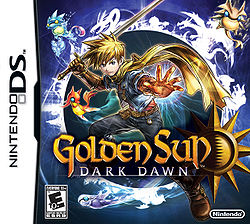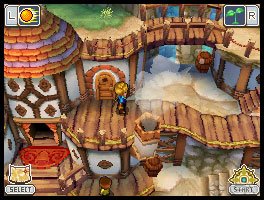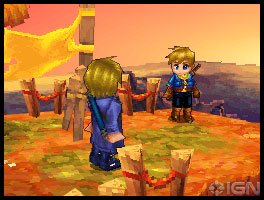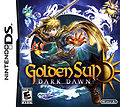Golden Sun: Dark Dawn: Difference between revisions
m (small changes.) |
No edit summary |
||
| Line 7: | Line 7: | ||
|developer=[[Camelot Software Planning]] | |developer=[[Camelot Software Planning]] | ||
|publisher=[[Nintendo]] | |publisher=[[Nintendo]] | ||
|producer=[[Takahashi Brothers]] | |||
|designer= | |designer= | ||
|composer=[[Motoi Sakuraba]] | |composer=[[Motoi Sakuraba]] | ||
Revision as of 07:59, 17 April 2012
| Golden Sun: Dark Dawn | |
|---|---|

| |
| Developer(s) | Camelot Software Planning |
| Publisher(s) | Nintendo |
| Producer(s) | Takahashi Brothers |
| Composer(s) | Motoi Sakuraba |
| Series | Golden Sun |
| Platform | Nintendo DS |
| Release Date | Japan: 28 October 2010 North America: 29 November 2010 Australia: 2 December 2010 Europe: 10 December 2010 |
| Genre | Hand-held role-playing game |
| Ratings | CERO=A ESRB=E10+ PEGI=12+ |
| Media | Nintendo DS cartridge |
Golden Sun: Dark Dawn (黄金の太陽 漆黒なる夜明, Ōgon no Taiyō: Shikkokunaru Yoake), announced June 2, 2009 at E3 2009, is the third game in the Golden Sun series. Originally shown as "Golden Sun DS," the game was revealed to have the subtitle "Dark Dawn" on June 15, 2010. The Takahashi Brothers describe this subtitle as "core to the story" and that it will become relevant and understandable as the story goes on, but they say that because "Dark" and "Dawn" are essentially opposites, it can be thought of as "darkness and light, destruction and revival."
The announcement of this title came over five years after the release of The Lost Age in 2003, something that the game director Shugo Takahashi expresses "more than a fair bit of regret about." [1]. Producer Hiroyuki Takahashi said in an interview in the Japanese-language famitsu magazine that unlike the two Game Boy Advance Golden Sun games, Dark Dawn is a stand-alone title. Nevertheless, as he said, they will "try to bring [the player] the enjoyment of imagining what the world will be like after the story ends." He also said "the first two games are prologues of this series. From this game on, it's the main story." [2] How this statement is worded and whether it implies further material after Dark Dawn is up for debate.
An August 30, 2010 press release describes the premise like so: "Taking place 30 years after the events of Golden Sun and Golden Sun: The Lost Age for the Game Boy™ Advance system, Golden Sun: Dark Dawn introduces a new generation of heroes that are struggling to survive in a radically changed world. What begins as a simple journey to rescue a lost friend turns into a dramatic quest to save the land from catastrophe as players are drawn into a world full of magical energy."
For information about hoaxes and fan speculation prior to this game's confirmation, see Golden Sun 3 Prerelease Speculation.
Plot and Setting
The initial playable cast that were the first characters to be revealed for Dark Dawn by E3 trailers and demo footage [3] are Matthew, a Venus Adept who is the son of the previous games' Isaac; Tyrell, a Mars Adept and son of the previous games' Garet; and Karis, daughter of the previous games' Ivan. [4] In addition, an August 2010 trailer released in Japan introduced as the fourth playable character a Mercury Adept later named Rief, the son of the previous games' Mia. A later scan revealed that Eoleo, now an adult and his father's successor as prince of Champa and scourge of the Eastern Sea, is a playable Mars Adept as well. Rounding out the playable cast are Sveta, a were-beast Jupiter Adept that fights physically; Amiti, a young Mercury Adept prince; and Himi, daughter of the previous game's Susa and Kushinada and a Venus Adept girl with the hidden powers of a seer.
Nintendo's press release at E3 2010 was the first source to indicate that Dark Dawn takes place thirty years after Golden Sun: The Lost Age. Major characters from the old games have been confirmed to make return appearances in far older forms: Isaac is now an adult, and he is depicted with facial hair and a blue trench coat. His biography states that following The Lost Age, Isaac built a cottage within the Goma area east of where his hometown of Vale used to be, and the survivors of Vale have since relocated and founded a new settlement around the cabin. From here, Isaac has watched the remains of Mt. Aleph from afar using his cottage's telescope, observing for strange occurrences. Adult Isaac is shown with speaking roles. Kraden is another returning character, revealed to still be alive even thirty years after the previous game.
The first hint of the plot was provided within teaser text shown at E3 2009. What follows is what is known of that text:
- ...of a disaster the likes of which had never been seen before.
- The heavens stormed. The lands quaked. The seas raged. Across the land, people prepared for the end of the world.
- The tale spread that this calamity was caused by some unknown soul who had released a forbidden power upon the world.
From the extended trailer at E3 2010 and other material released to the public prior to the game itself, much more of the plot and premise has been revealed. A series of taglines indicates that something "went wrong" with the Golden Sun during its return to the world of Weyard, thus causing the state of relative peace across Weyard to be thrown into discord at the start of the game:
- "A generation has passed since the Golden Sun rose above Weyard..."
- "The world has been reborn."
- "The Golden Sun was supposed to bring life back to the world. But something has gone wrong."
- "A new generation must rise to the challenge."
- "And they must do everything in their power to drive back evil."
As shown in the trailer, the embodiment and/or result of whatever it was that "has gone wrong" is the appearance of dark spheres across Weyard that may be akin to black holes, such as near one town that Matthew and his friends are seen watching along with some townspeople. These are described by Nintendo's E3 press release as Psynergy Vortexes that suck in all Psynergy from both Adepts and the land itself, and the plot initially concerns the main characters being drawn into the mystery behind these phenomena.
This video from the floor demo at E3 2010 granted the opportunity to explore the game's beginning town that is the spiritual successor to Vale (its background music is an arrangement of the Vale theme), and this later four-page article that appeared in a Japanese-language July Famitsu article when translated, gives a more thorough understanding of the outset. The suppressed elemental powers that were released into the world at the end of The Lost Age were so great that they effectively aroused a recreation of heaven and earth. Natural disasters proceeded to transpire all across the world, and Weyard's equivalent to the Earth's crust became displaced, causing the continents themselves to be quite different in size, shape, and physical state 30 years later by the time Dark Dawn takes place.
Peace has more-or-less returned to these lands after healing from the wounds created by the Golden Sun, and the world's people now dwell in towns and villages amongst natural backdrops that have become more vivid than before. For example, what was once the Goma Range, a mountain range that walled off sections of the continent, is now a crevice-filled highland, and this is where the village that is the "new Vale" has been settled. This village is therefore in close proximity to Bilibin, which now owns a much larger area of land. Lord McCoy, however, has stepped down from his position as lord of Bilibin. Various trailers have shown that there seems to be far more demi-humans inhabiting Weyard now, of which Sveta is a representative, and Sveta's biography states that man-beasts mutated in response to the Golden Sun's appearance.
But because of the chaos that Alchemy's release had caused, people across the world have differing opinions on the ones who released it, the previous games' protagonists, also known as the "Warriors of Vale." Confirmed NPC gossip says that Sol Sanctum, formerly hidden from world knowledge three decades beforehand, became widely known about after the Golden Sun's appearance. Some recognize that the Adepts from Vale saved the world, but others would go so far as to think they are the ones who destroyed it. The Adepts' children would carry this burden both before and during Dark Dawn, having grown up respected by some and despised by others. In regard to whether the now-adult characters from the previous games beyond Isaac and Kraden will make appearances in this game, Shugo Takahashi simply says that while Camelot can't divulge this quite yet, there will be surprises in regards to this. The next generation of protagonists, in the meantime, will be exploring catacombs representing ancient civilizations as a main part of their journey.
Subsequently released information here (translation) introduces a mysterious country named Tuaparang that figures in the game's events, and two of its commanders, the warlike Blados and the bewitching Chalis, are set up as antagonists. Tuaparang excels in the sciences and in military power, and conducts secret maneuvers. For a currently unknown reason, its commander contacts Matthew and his friends, and Blados and Chalice encounter them repeatedly throughout the game. It is stated that it is as though they are using Matthew's group. Another member of Blados and Chalis' circle, Arcanus, bears extreme resemblance to Alex from thirty years earlier, and his actions and those of Matthew's group will together have a great effect upon the fate of Weyard.
The game features an encyclopedia system designed to bring up to speed players that may have played the previous games or not, and explain plot and character elements occurring in the present. As characters talk, specific text will highlight with hyperlinks, and if the player taps on the text with the stylus, that term's page from the encyclopedia will open up on the upper screen to fill players in on the details. If the page has already been read beforehand, the hyperlink will remain, but in a darkened color. [5]
Gameplay

The game features a world with 3D environments and entirely 3D battles, and it features optional touch-screen stylus control. Stylus control appears as an additional way of controlling the functions that can otherwise be handled by the base control scheme from previous games, with touchable icons on screen that quickly and easily select and use Psynergy shortcuts. The ability to handle the controls without the stylus is affirmed by the game's producer in a 1up.com developer interview. Videos of E3 show this to be the case with Psynergy like Move and a new "Fireball" Psynergy that can burn objects on the field from a distance.
Eight all-new playable characters comprise the eventual final party, and unlike in previous games where there would be four characters at first and then suddenly jump up to eight, the full party is assembled at a steady rate as the game progresses. Characters are more-or-less similar in battle to previous games, but one of the characters, Sveta, has an entirely different battle style in which she transforms between humanoid and werewolf forms, where even her Attack and Defend commands are altered. Once again, there are 72 Djinn to collect, 18 for each element and therefore 9 for allocation to each of the eight playable characters; however, some of the Djinn themselves are different. Some of the otherwise missing Venus and Mars Djinn are present on adult Isaac and Garet, who join battles as uncontrolled "guest" characters in the beginning stages of the game. Each Djinni now has its own unique design variation to differentiate it from all of the other Djinn of the same element.
The Class system is very similar to the original games in terms of how Djinn influence them, but in accordance with the new characters there are four new mono-element classes and two new dual-element classes, and some of the existing classes have been slightly retooled, such as with the Wind Seer series now having its own party-healing Psynergy. Classes provided by Class-changing items like in The Lost Age no longer exist, however.
All 29 Summon spirits from the Game Boy Advance titles return in Dark Dawn, reimagined for 3D, in some cases visually appearing exactly like a 3D version of the original entity and in other cases having received drastic redesigns (Megaera, Procne, and Neptune, in particular, appear more sinister than they did before). One all-new summon, a Venus-aligned summon named Crystallux, is added; it is the chandelier dragon featured in the original "Culture Advanced" commercial for the original Golden Sun. This makes for a total of an even 30, and like in The Lost Age, the party starts out with access to the "initial 16" and must collect the other 14 by finding their Summon Tablets in the game world. Djinn that are On Standby now wander around the top screen of the DS in 2D while the battle takes place in 3D below.[6] When a summon sequence is used, the appropriate amounts of Djinn from the upper screen visibly disappear.
Psynergy old and new makes fully 3D appearances as well, such as the Move Psynergy being used to shift objects around. Growth, in particular, is now inherent to Matthew regardless of class series (without its upgraded forms, mad Growth and Wild Growth), so that he can use it as a utility Psynergy effect without having to constantly change classes. Certain Psynergies previously usable only as field utility Psynergy, such as those involving the familiar incorporeal hands, can now be used as battle effects as well.
Items and their categories are similar to the previous games, but with several important changes and additions. Long Swords are usable by Matthew and Tyrell; Axes are usable by Matthew, Tyrell, and Eoleo; Light Blades are useable by Matthew, Tyrell, Karis, Himi, Eoleo, and Amiti; and Maces are usable by Matthew, Tyrell, Rief, and Eoleo. Staffs, however, have been divided into Staffs and Ankhs, the latter of which is more of a restricted sub-category - while Karis, Rief, Himi, and Amiti can use Staffs, only Rief and Himi can also use Ankhs. Bows are an all-new weapon type usable by Karis and Amiti, and Sveta, the only bestial fighter of the group, uses her own category of weapons called Claws. Defensive equipment on the whole is less changed, though Shirts have been removed as supplementary equipment, while Rings have more emphasis on increasing stats than before, where they had almost entirely been about being Usable as items. Every single weapon in the game has its own, unique 3D model that appears held by a character during battle. All weapons have Unleash effects, and they have multiple unleashes; weapons gain unleashes when the character gains experience with the weapons in battle in a new weapon-experience system. Unleashes themselves have a wider array of effects as well, such as being able to hit all enemies on the battlefield at once.
Battle is very similar to the previous games, in that a party of four characters fights an enemy group, reserve party members may be switched in once per turn, and when the first party is all downed, the reserve party jumps in. Perhaps the most critical change is that when a character is set to attack an enemy, but another character has defeated that enemy beforehand in the same turn, the character will no longer automatically Defend; their attack will be redirected to another enemy on the battlefield.
There is no connectivity with Golden Sun: The Lost Age, even though GBA games can be inserted in the GBA slot of older DS systems. Furthermore, there is no Easy mode or Hard mode to replay the game with.
Gameplay Information
See the quick spoiler-free walkthrough for a "perfect" rundown of the game's progression and secrets in a general overview style.
Tricks and Secrets
See the full list here.
E3 2010 Press Release
The official press release contains the following text:
|
Release
The Japanese release of Dark Dawn was on October 28, 2010. Also released was a promotional package titled Golden Sun: Dark Dawn - Adept's Navigation Guide, billed as a "magazine book". It features the following information:
- Character analysis files
- Introductions to locations via setting design showcases
- Story explanation of past and present events
- Game system explanations, such as Psynergy, Djinn, and Summon
- A map-based walkthrough of the full game, with marked chest, Djinn, and Summon locations
- Lots of data concerning Items, Classes, Djinn, Summons, etc.
Also packaged with the book were two bonus products: An OST soundtrack CD of Dark Dawn music, and a special Dark Dawn manga appearing in V-Jump December 2010, illustrated by Higashimoto Kazuki. It depicts the main characters setting off on their journey and engaging in heated battles with adversaries. Includes a signed autograph on colored paper.
The game was released in North America on November 29, 2010.
- GSDDMatthew.jpg
Official promotional art of Matthew
- GSDDKaris.jpg
Official promotional art of Karis
- GSDDTerrell.jpg
Official promotional art of Tyrell
Official promotional art of Rief
Official promotional art of Amiti
- Stella.png
Official promotional art of Sveta
Official promotional art of Eoleo
- Img himi.jpg
Official promotional art of Himi
- DDIsaac.png
Official promotional art of Isaac
- KradenDD.png
Official promotional art of Kraden
- GSSpade.jpg
Official promotional art of Blados
- GSHeart.jpg
Official promotional art of Chalis
- GSDDAce.jpg
Official promotional art of Arcanus
Matthew at Patcher's Place.
Matthew at Konpa Ruins.
Matthew walking through Patcher's Place, with a Mars Djinni "Forge" visible above.
Atalanta summon sequence
Offical art of Isaac's Lookout Cabin
Official art of Patcher's Place
Official art of Goma Plateau
Trivia
- The August 2009 issue of the U.K.-circulated Official Nintendo Magazine made the erroneous claim that the main playable character seen in the E3 trailer, later known as Matthew, was Isaac himself, rather than a descendant of Isaac as confirmed by the E3 press release. [7] Nintendo Power reported him to be Isaac's son beforehand.
External Links
- Official Website (Japanese)
- Official Website (English)
- Official Website (Spanish)
- Leaked footage from the first twenty minutes of the Japanese version of the game, originally posted on NicoVideo.
- English trailer showcasing bows to be a weapon type.
- Adventure trailer
- Commercial and Djinn trailer
- Class Change and Djinn Battle pre-release instructional videos.
- September 15, 2010 abilities trailer
- August 30, 2010 press release
- August 2010 Japanese Wii Nintendo Channel Trailer
- E3 2010 Trailer
- GameTrailers E3 2010 Floor Demo Part 1: Adventure Mode
- GameTrailers E3 2010 Floor Demo Part 2: Battle Mode
- E3 2010 Floor Demo Battle Mode footage by NintendoWorldReport
- More E3 2010 Floor Demo general footage, featuring the playthrough of the demo dungeon
- More E3 2010 Floor Demo footage by RPGamer, featuring the full battle mode and the exploration of the town.
- DigitalChumps High-Definition Adventure demo playthrough part 1 and part 2
- 1up.com news storyabout E3 2009
- E3 2009 Gametrailer footage, showing 3D graphics, presented by Reggie Fils-Aime
- Extended footage of gameplay from E3 2009 (close-up of bottom screen)
- La Taberna del Adepto (Spanish)
- Golden Sun: Adept's Refuge Dark Dawn Guides
Magazine article compendium
- 9/30/2010 Jump Magazine scan introducing adult Eoleo and antagonists Spade and Heart. Translation here.
- September Famitsu scan, with translated version (9/9/10)
- V-Jump scans with translation (8/23/10)
- Further scans (8/7/10)
- Scans from Shonen Jump magazine, with translation. (8/05/10)
- Two scans of Japanese-language Famitsu with translation, and an accompanying 1up developer interview with the Takahashi brothers. (7/21/10)
- Weekly Jump scan and translation (7/14/10)
| Golden Sun games and media | |
|---|---|
| Main Series Games | Golden Sun • Golden Sun: The Lost Age • Golden Sun: Dark Dawn |
| Cameos: | Super Smash Bros. Brawl & Ultimate |
| Other Media: | 4-Koma Gag Battle • Dark Dawn V-Jump manga |
| Other Information: | Game data directory • GBA plot summary • Dark Dawn plot summary • Staff Credits |




















